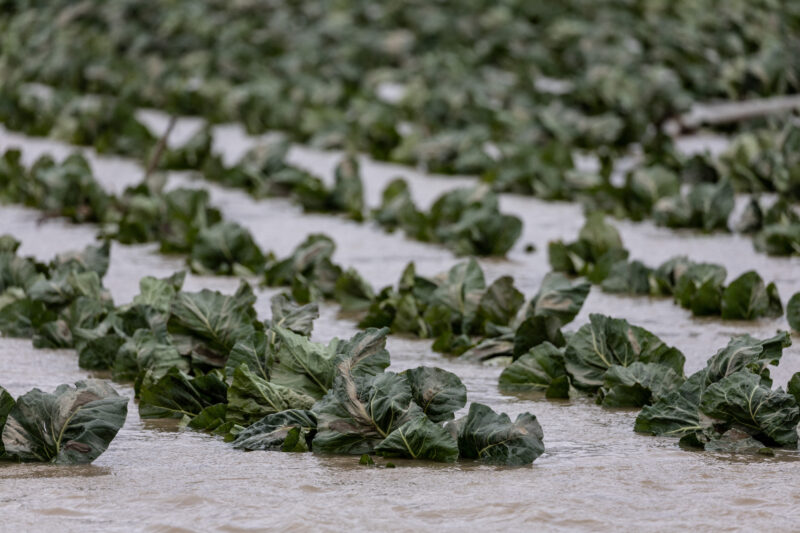NEW YORK (Reuters) -The latest in a series of atmospheric river storms soaked California on Tuesday, bringing another deluge of rain to the already-saturated state, while a Nor’easter swirling over New York and New England prompted emergency orders and closed roads.
Up to 10 inches of rain were forecast in some areas of California, while up to 3 feet of fresh powder was expected to hit elevations of 5,000 feet and above, where snowdrifts already reach rooftops, according to the National Weather Service (NWS).

Along California’s coast and lower inland areas, the heavy rain and melting alpine snow raised the risk of more flooding as rivers and streams overflow their banks, compromising levees. Wind gusts up to 70 mph could uproot trees, downing power lines.
“Lives and property are in great danger from Tuesday into Wednesday,” the weather service said in its California forecast, warning residents to expect flash flooding in areas that do not normally experience it.

In anticipation of the “atmospheric river” — a narrow current of air laden with dense tropical moisture from the ocean — emergency crews stepped up sand-bagging operations in recent days and mounted round-the-clock patrols of levees and rain-swollen riverbanks.
Nine atmospheric rivers already lashed California in rapid succession from late December through mid-January, triggering widespread flooding, levee failures, mudslides and punishing surf. At least 20 people perished.
Massive flooding from failed levees on the Pajaro River in Monterey County this weekend prompted hundreds of evacuations and dozens of water rescues.

Officials on Sunday closed a bridge section of Highway 1 connecting Monterey to Santa Cruz County because floodwaters are eroding an embankment containing its support beams, according to a California Transportation spokesman. There’s no timeline for its reopening.
“The impact of this is really ramping up today,” said Marc Chenard, a meteorologist with the NWS Weather Prediction Center in College Park, Maryland. Most of the heavy weather would occur on Tuesday and Wednesday, he said, but flooding will persist.
Mandatory evacuation orders remained in effect for residents in 10 California counties on Tuesday, according to the Federal Emergency Management Agency. The greatest flood risks are from California’s Central Coast to the southern Sierra Nevada foothills.

Chenard said that at elevations higher than 5,000 feet, the snow pack will absorb the rain like a sponge. But the real risk is at lower elevations where rain runs off the snow, melting much of it and bringing floods and mudslides.
At Front Porch Farms in Healdsburg about 70 miles north of San Francisco, Tommy Otey said he was glad to see his 11 million-gallon reservoir filling, after years of historic drought that parched California and forced his farm to downsize.

“This should last us the whole season,” said Otey, who primarily sells flowers to Bay Area florists.
Experts warn that climate change is causing more severe droughts and heat waves in California, punctuated by occasional but excessively rainy wet years.
‘IMPOSSIBLE’ TRAVEL IN NORTHEAST
In the Northeast and New England, a Nor’easter storm had already dumped 20 inches of snow in the Berkshires in western Massachusetts and northwestern Connecticut, and 8 inches of snow had fallen in Albany, New York. Forecasters expected as much as 2 more feet of snow to fall on Tuesday.
More than 267,000 homes and businesses were without power in the Northeast, including New York, Massachusetts, New Hampshire, Vermont and Connecticut, according to data from PowerOutage.us.

In Pittsfield, Massachusetts, about 130 miles west of Boston, police urged motorists to stay off the roads.
Rock salt and snow shovels were flying off the shelves on Tuesday at Rocky’s Ace Hardware in Worcester, Massachusetts, 40 miles west of Boston, said the manager, Joshua Rivera, 21.
About 5 inches of snow had dropped in the city by noon and it was still coming down hard as the afternoon began.
“It’s getting pretty bad out there, but we’re going to try to stay open,” Rivera said.
In New York, Governor Kathy Hochul declared a state of emergency Monday night for 37 counties covering Albany, Central New York and the Mid-Hudson and North Country regions. In a statement, she urged New Yorkers in affected regions to “stay home and avoid any unnecessary travel to allow plow crews to do their job.”
New Jersey Governor Phil Murphy declared a state of emergency for five counties, and Connecticut Governor Ned Lamont activated the state’s emergency management center on Tuesday morning to monitor the storm.
Heavy snow could fall at a rate of 2 inches an hour in some areas of upstate New York with high winds, making travel impossible, the NWS said.
(Reporting by Rich McKay in Atlanta and Nathan Frandino in Monterey County, California; Editing by Aurora Ellis)

